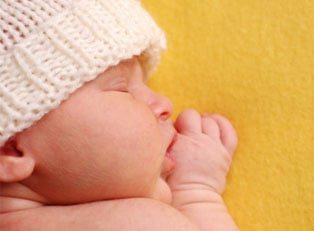Baby Coordination at 3 Months
The period from birth to three months is often called the 'fourth trimester' because babies spend the entire time getting used to life outside the womb. At 3 months, your baby will start developing all sorts of fun new skills, and hitting some early developmental milestones. She will begin to get control of her body and start to discover exciting things like fingers and toes. Your baby is also beginning to lose some of the reflexes she was born with, like grasping things with her hands.
Hand-Eye Coordination
At birth, your baby's vision was blurry. According to the American Optometric Association, she could focus on things approximately 8' away from her face, about the distance between her face and yours while breastfeeding. Now her vision is becoming much more acute. Hand-eye coordination develops first with visual tracking, as your baby learns to follow moving objects with her eyes. Next she will begin reaching for things. You can start helping her vision develop by stimulating her with brightly colored objects and boldly contrasting patterns.
Hand-eye coordination is a complicated skill. Not only does your baby need to be able to control her arms and hands, she also must understand how to reach and grasp and object. At three months she will not always be able to grab the object of her desire on the first try. Over the next month, be ready for her to use her entire body to reach for things she wants.
Physical Development
At 3 months, your baby should be able to open and shut her hands deliberately. Her hands should no longer be curled into tiny fists when she sleeps. According to the American Academy of Pediatrics, a three-month-old should be able to stretch out and kick when lying on her back, and raise her head and chest up when lying on her stomach. She should be able to deliberately grab an object, and then drop it when she is done with it. At this age, she will also start grabbing things and putting them in her mouth as a way of exploring them. She should be able to grab and shake a rattle deliberately.
As your baby begins to move deliberately and with purpose, you will want to be even more careful about where you put her. According to the American Academy of Pediatrics, she may begin rolling over onto her back during tummy time. As your baby learns to move her body around more and more, you will want to avoid setting her on beds, counter tops, changing tables, and other surfaces. Even if she hasn't started rolling quite yet, if she isn't strapped securely into place, the floor is the safest place for your baby.
Beginning to Mimick
Your 3 month old is very observant, and spends nearly all of her waking time watching and learning from the people around her. She should begin to mimic some of the expressions and movements you make. Your baby may be ready to play games like paddy-cake and so-big. You will get plenty of social smiles, and your baby may also start copying different faces. She should also be capable for using her voice for something other than screaming and crying now, so expect to hear some delightful cooing and babbling. Don't expect any words yet, it will probably be a few months before she is ready to make consonant chains like ba-ba-ba-ba.
Warning Signs
If your baby cannot successfully pick up a toy by 3 months, you should speak to your pediatrician. If she cannot track moving objects with her eyes, or deliberately let go of a toy, you will also want to mention this at her next well baby visit. Each baby develops on their own schedule, but certain delays could point to a potential problem. Your pediatrician will have the information you need, and most cities also have early intervention programs that can help you determine if your baby is truly delayed or just a late bloomer. Remember that many babies make huge gains in one area, like speech, while they lag behind in other areas, like physical coordination. Slow development in every area is often cause for concern.



